Is it possible to keep an egg in good, edible condition safely for years? Well, we’re going to find out all about that in this article. So, keep reading.
What Is Preserved Egg?
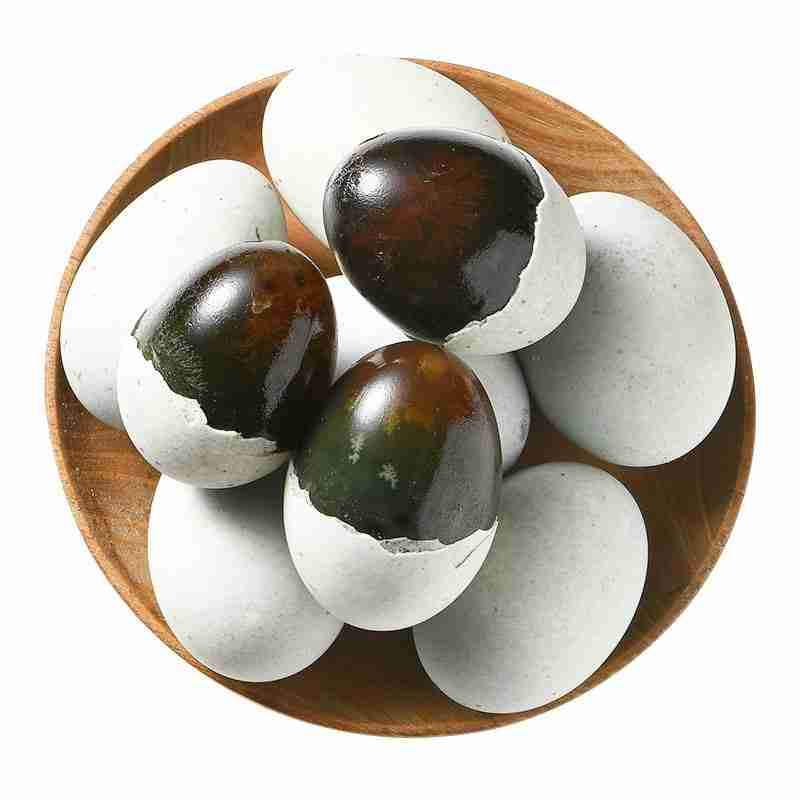
The Pi dan/Century Egg, also known as preserved eggs, hundred-year eggs, thousand-year eggs, thousand-year-old eggs, century-old eggs, millennium eggs, leather eggs, skin eggs, black eggs, or old eggs, These patterned eggs are regarded as having better quality than the normal century eggs and are called Songhua eggs, also known as pine flower eggs or pine-patterned eggs. The eggs turn into the color black, and they also have a dark green yolk, which really is expected of the eggs after they have been processed for weeks or, in other cases, months, in ash, clay, or even in quicklime mixed with salt.
There is a common misconception about the century eggs, though, especially the ones claiming that the eggs are more than one hundred or perhaps thousands of years old. This is untrue, and it would also be impossible to keep an egg in a safe, edible state for that long. The most common century eggs are, however, only a few months old.
The other important thing that you need to know about the preserved century egg is the fact that this egg has a very intense taste. And serving the egg is done in a way that honors traditions.
The century egg has a fascinating history, though. And in this article, we’ll take you through the basics of the preserved eggs, as well as the history of the century egg.
Century Egg History
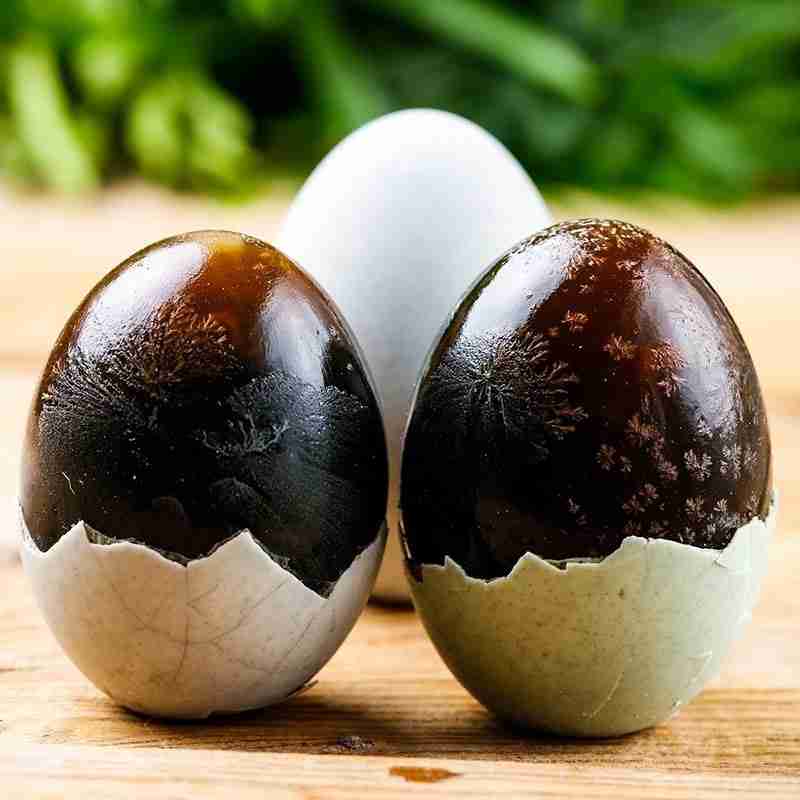
The century eggs are believed to have originated in China’s Human province, during the reign of the Ming Dynasty, which ruled China at least 6 centuries ago. But given how old the century eggs have been around, there are many stories regarding the century eggs.
The most popular tale of the century egg is the story about a man that discovered the century eggs at an abandoned site when his home was under construction. In his discovery, the man came across duck eggs, which had been sitting in the slaked lime in the construction site for about 2 months. He opted to eat the eggs and was surprised by the taste of the eggs. It is said that he only needed to add salt to the eggs.
However, this is not the only tale about the eggs. There is also a more romantic story regarding the century egg. This tale is just as popular. The story is about a man that had left the eggs in the garden of a woman he was interested in courting. The woman didn’t discover the eggs’ existence in the ash pit until about 2 weeks later. Upon the discovery, more than half a month later, the eggs were in a good state, and it led to the discovery of the century eggs.
There is also the story of the farmer who came across duck eggs that had been preserved naturally in water plus slaked line, which is typically calcium hydroxide.
Despite these fascinating monikers of the century eggs, the millennial eggs, or the 100-year eggs, the ‘so-called century egg’ is still metaphorically a Century egg, because in most cases, these eggs are more than a few weeks or months old.
The century egg is also known as the pine-patterned egg because of the pine branch shape and the woodland-looking and intricately patterned features on the egg white and the surface of the egg. It is a great dish throughout China, but also in the rest of East Asia.
Historically, this egg dish was created because food needed to be preserved, and all extra foods would be preserved. Preservation of the eggs led to the creation of the century eggs which are preserved in some sort of alkaline paste.
However, despite the documented details about the eggs, the real history of the eggs remains largely unknown, and the records from the Ming Dynasty represent the earliest known records of the existence of the century eggs. And though most of the century eggs were created and preserved by the villagers and farmers hundreds of years ago, the appearance of eggs in Hong Kong menus only dates back to the 1940s.
How To Make Century Eggs
The century eggs are created from either duck or chicken eggs which are preserved in an alkaline solution for an extended duration.
Traditionally, the preparation of the century eggs involves putting the eggs in a mixture of salt, lime, as well as ash. Afterward, the eggs and the mixture are wrapped in the rice husks for weeks or even months.
The modern method is different, though, and it is also very straightforward, with most of the ingredients substituted for the ingredients used traditionally. So, century eggs are today made of sodium carbonate, calcium hydroxide, and table salt. These are all wrapped in plastic, and all you will need to do is to peel and then rinse the eggs once the eggs are ready to be eaten.
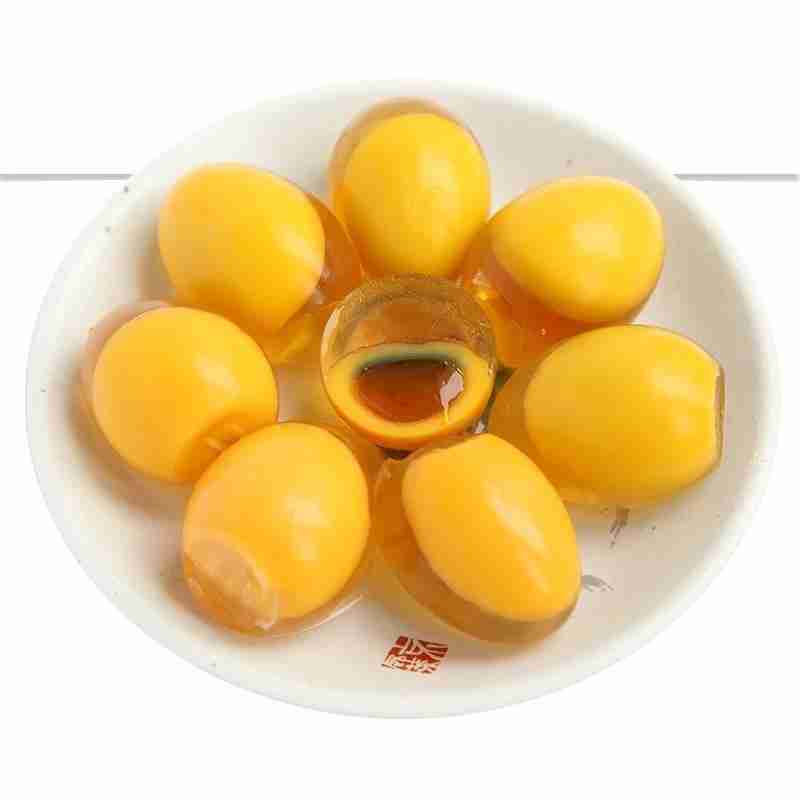
The biggest misconception about all this is that the century eggs would be spoilt after all that time, but this is not really the truth. Instead, the eggs in the alkaline solution are only preserved. The eggs are also safe and free from mold and bacteria, which is why the century eggs are such a big deal.
How To Cook Century Egg
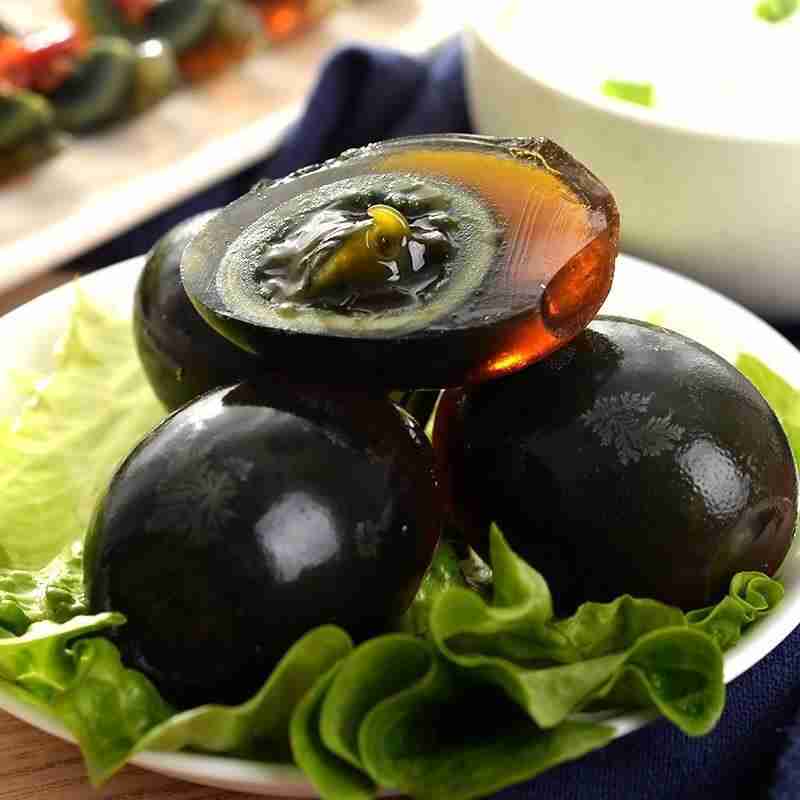
If you have been to Hong Kong, you may have learned that the century eggs are sold in many restaurants, some of which specialize in the best of century eggs. These eggs feature proportionately larger eggs yolks, but they often remain runny and greenish-yellow and also surrounded by specific concentric rings in navy blue, brown, and green. And you may be interested in learning about the eggs or even tasting them. But how do you cook the century egg?
Well, as mentioned above, the eggs are not cooked; they are preserved in an alkaline solution and are packed away in rice husks for weeks or even months, in even cases. In other words, the century eggs are cured eggs and not really cooked eggs – at least not in the traditional sense.
If you want to make the century eggs at home, follow the following steps:
- Mix ash, salt, clay, water, and quicklime to make a kind of paste
- Apply a thick layer of the paste to completely cover the raw eggs.
- Now roll these eggs in the rice grain husks. This prevents the eggs from sticking with each other.
- Once done, store the eggs in an airtight container, and then store the eggs in the dark. Let them sit for several weeks.
How To Eat Century Egg
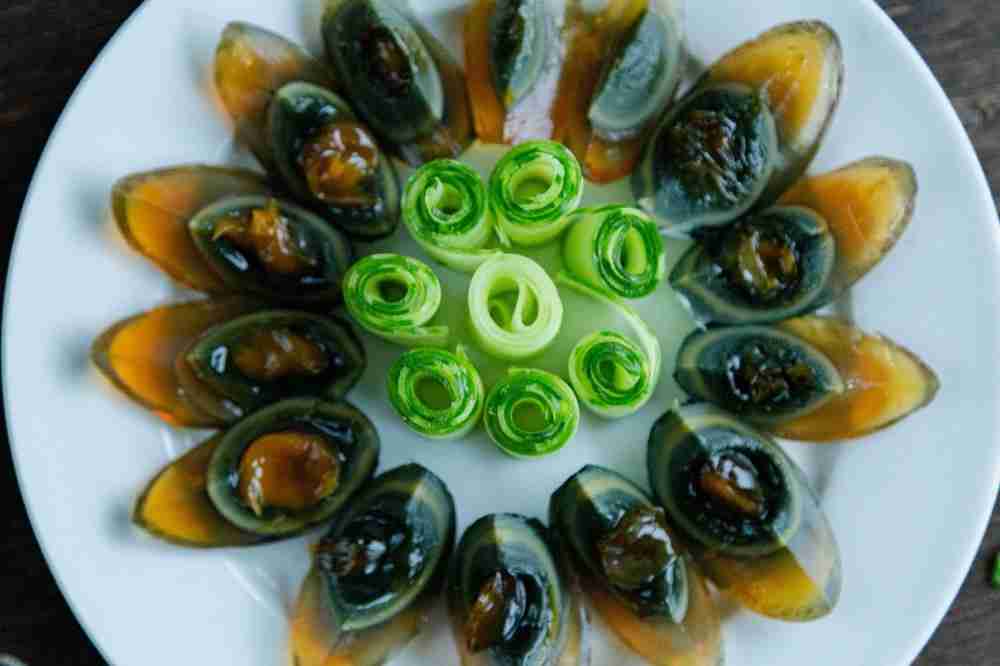
Before we look at how to eat the century eggs, how about a look at how the century eggs taste?
Well, many people have a very strange first impression of the century eggs, but during the preservation or the preparation process, the proteins and fats that are initially flavorless are broken down, and they become very flavorful. During the breakdown process, the egg white takes on a dark-brown appearance, and it looks like this translucent jelly that is salty. The egg yolk, on the other hand, takes on a dark grey or green color.
Once ready, the eggs have a consistently smooth and very creamy feel and more of a succulent taste. It is often eaten with tuna, and it will leave a silky taste in the mouth when you eat it.
But even if you can stand the taste – most people consider the taste of the century eggs an acquired one – the smell of the eggs is very strong, as expected. The strong smell, along with the intense flavor of the eggs, comes from the hydrogen sulfide and ammonia present in the eggs.
Why Century Egg Is Black?
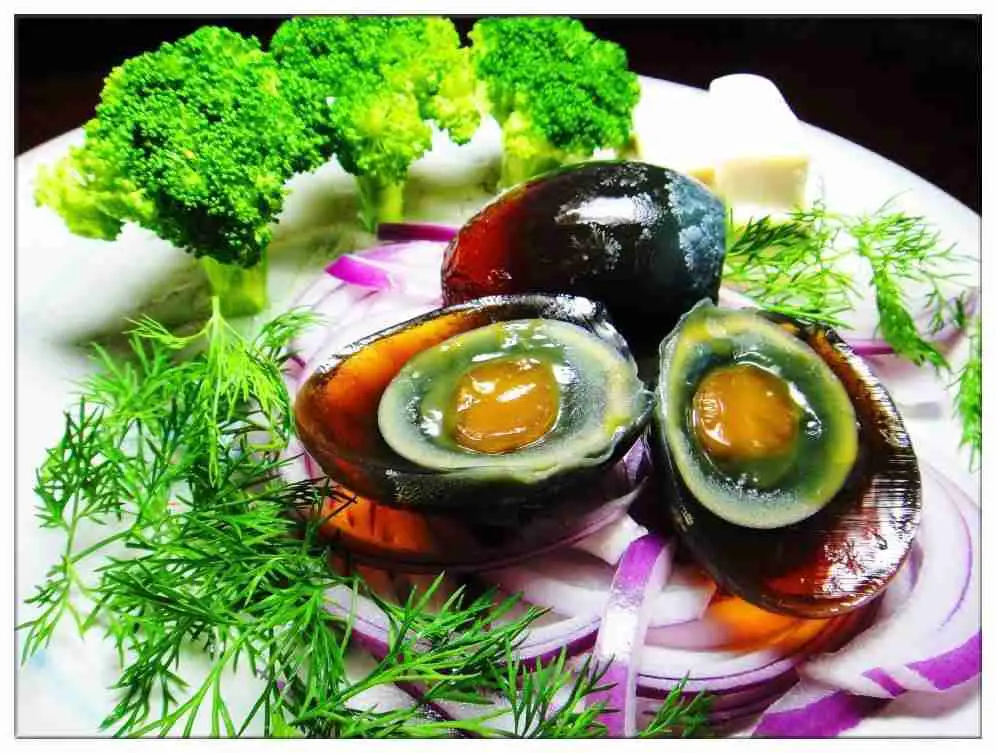
The century egg has a distinct black hue because of the Maillard reaction, which is a natural browning effect, often accelerated by the highly alkaline environment that the eggs are prepared in. The sodium hydroxide that the century egg is made in is what increases the discoloration of the eggs. It also breaks down the protein in the eggs into amino acids and glucose that makes the eggs more flavorful.
To enjoy the eggs, you may have to combine them or serve them with roasted pepper or eat them with silken tofu.
But you will need to slice the eggs into small wedges first – the eggs may stick on the knife, but this is normal and expected.
Next, roast some bell peppers, then slice them thinly in strips and serve them with the eggs.
Note that you don’t have to cook the eggs after taking them out of the preservation container.
Is Century Egg Healthy?
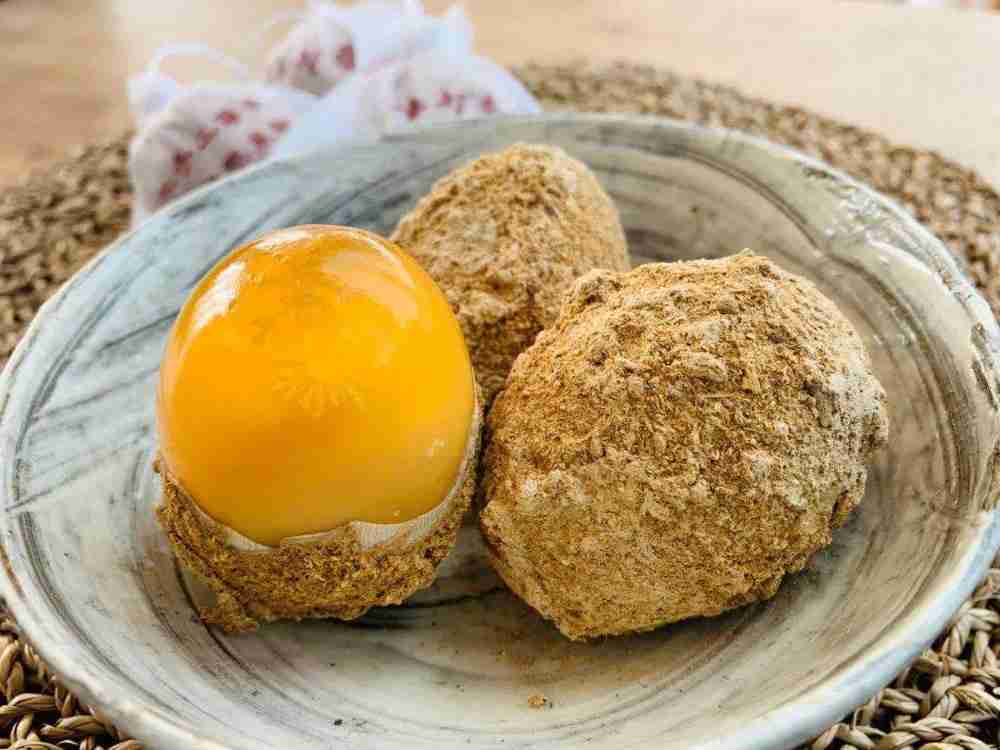
Yes, the century egg is not only healthy but also very nutritious to your health thanks to its richness in amino acids, iron, and vitamin E.
Unfortunately, the denatured proteins after the preservation are not easily absorbed in the gut.
Century Egg Pros And Cons
Pros
- The eggs are tasty, with a smooth, creamy consistency
- The ammonia and hydrogen sulfide add flavor
- The broken-down proteins and amino acids are very beneficial to the body
- Great source of vitamins D and E.
- Excellent selenium source
Cons
- The denatured proteins are not absorbed in the gut easily
- They are an acquired taste
- The smell is too strong
century egg vs tea egg
Century egg and tea egg are both popular traditional Chinese snacks that are often consumed as a side dish or appetizer.
Century egg, also known as preserved egg or thousand-year egg, is made by preserving duck, chicken or quail eggs in a mixture of clay, ash, salt, quicklime, and rice straw for several weeks to several months until the yolk turns dark green or grey and the white becomes translucent jelly-like consistency. Century egg has a strong and unique flavor, and is commonly eaten with congee or rice porridge.
Tea egg, on the other hand, is made by hard-boiling eggs and then cracking the shells without peeling them completely, and then simmering them in a tea-based broth made of soy sauce, Chinese five-spice powder, and tea leaves. The tea leaves and spices give tea eggs a fragrant and savory flavor. Tea eggs are often sold as a street snack and are a popular food item during festivals or celebrations.
In terms of taste, century egg and tea egg have different flavor profiles. Century eggs have a strong and pungent flavor, with a unique umami taste, while tea eggs have a more subtle flavor with a fragrant and savory taste. The texture of century egg is also very different from that of tea egg, with century egg having a gelatinous and almost slimy texture, while tea eggs have a firmer texture similar to that of a hard-boiled egg.
Both century egg and tea egg have their own unique cultural significance and are widely consumed in China and other parts of Asia. While they may not be to everyone’s taste, they are popular snacks enjoyed by many people who appreciate their distinct flavors and textures.
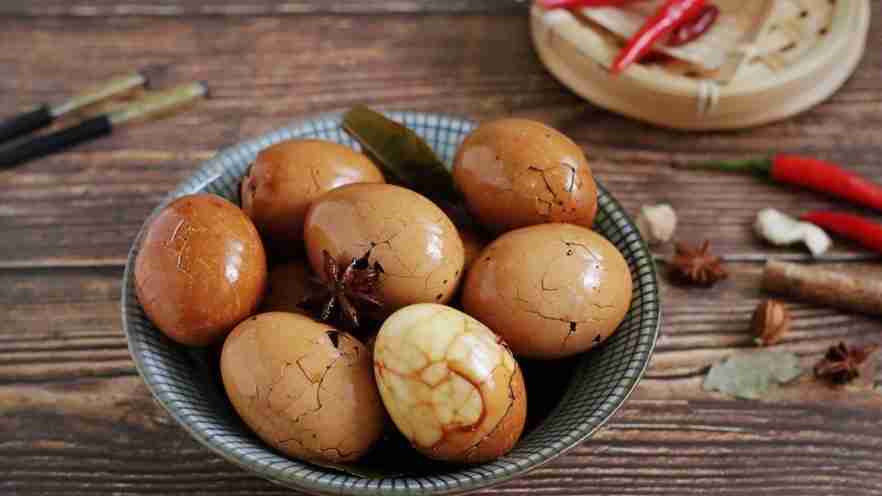
century egg vs salted egg
Century egg and salted egg are both preserved eggs commonly used in Chinese cuisine, but they have different flavors and textures.
Century egg, also known as thousand-year egg or preserved egg, is made by preserving duck, chicken or quail eggs in a mixture of clay, ash, salt, quicklime, and rice straw for several weeks to a few months. During the preservation process, the pH level of the egg yolk rises, which results in a jelly-like texture and a pungent aroma. The egg white turns a translucent brown color with a gelatinous texture, while the yolk becomes a creamy grayish-green color with a strong, savory flavor.
Salted egg, on the other hand, is made by soaking duck eggs in a brine solution made of water, salt, and sometimes spices for several weeks to a few months. The salted egg white becomes firm and salty, while the yolk turns creamy and rich in flavor.
In terms of flavor, century egg has a strong, pungent taste and aroma, while salted egg has a salty and savory flavor. The texture of century egg is jelly-like and creamy, while the texture of salted egg is firm and crumbly. Additionally, century egg is often served as a cold dish or used in congee or porridge, while salted egg is often used in cooking or as a condiment in dishes such as salted egg yolk prawns.
Overall, century egg and salted egg are both unique and delicious preserved eggs with different flavors and textures, and they can be used in a variety of dishes in Chinese cuisine.
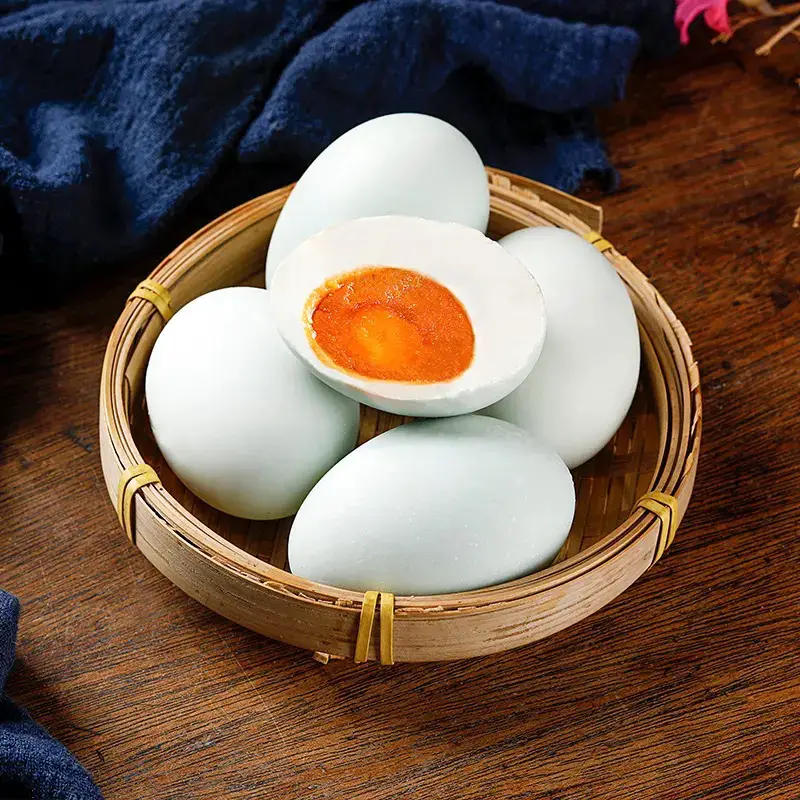
century egg and tofu
Century egg and tofu is a classic Chinese dish that combines two ingredients with distinct flavors and textures. The dish is commonly known as “pi dan dou fu” in Mandarin, which translates to “century egg tofu.”
Century eggs are a preserved food made by preserving duck, chicken or quail eggs in a mixture of clay, ash, salt, quicklime, and rice straw for several weeks or months. The process causes the egg white to become a translucent, jelly-like texture and the yolk to turn a creamy, greenish-black color with a distinct umami flavor.
Tofu, on the other hand, is made from soybeans that are soaked, ground into a paste, and then boiled. The resulting liquid is curdled and strained to create tofu, which can be prepared in various ways, such as steaming, stir-frying, or deep-frying.
When combined, century egg and tofu create a dish that is both savory and satisfying. The soft and silky texture of the tofu complements the rich and flavorful century egg. The dish is often served with a variety of seasonings, such as soy sauce, sesame oil, chopped scallions, and cilantro, which enhance the flavors of the ingredients.
Overall, century egg and tofu is a delicious and unique dish that is enjoyed throughout China and in many Chinese communities around the world. It is a testament to the creativity and ingenuity of Chinese cuisine, which has a long history of combining diverse ingredients to create dishes that are both flavorful and nutritious.
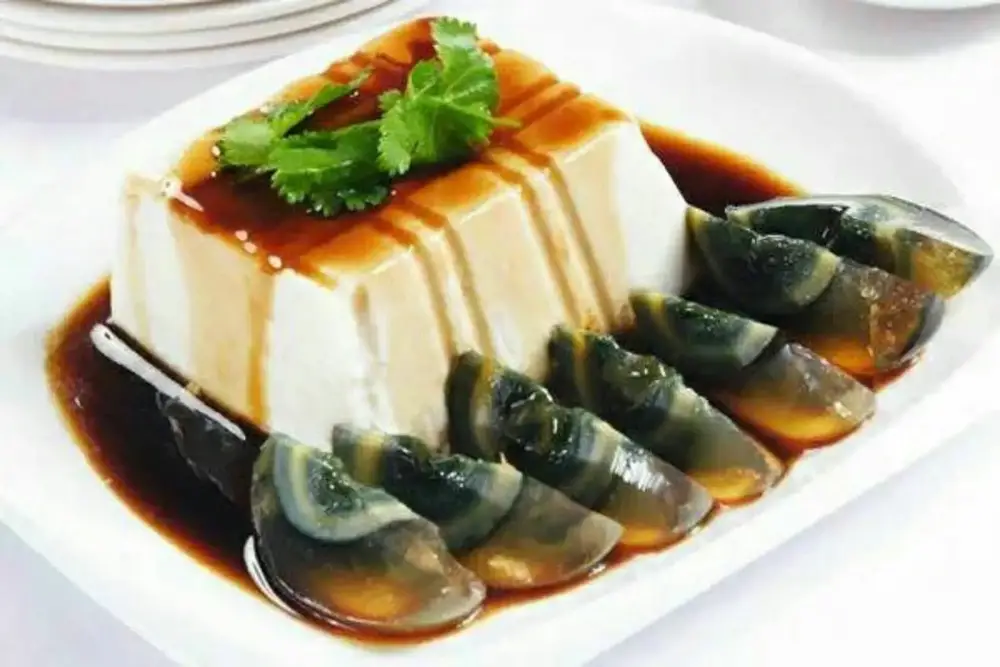
century egg vs Stinky Tofu
Century egg and stinky tofu are two very different foods, with distinct flavors and textures.
Century egg, also known as thousand-year egg or preserved egg, is a Chinese delicacy made by preserving duck, chicken or quail eggs in a mixture of clay, ash, salt, quicklime, and rice straw for several weeks to several months. This process transforms the egg white into a jelly-like consistency while the yolk becomes a dark greenish color. The flavor is salty, savory, and sometimes slightly sweet, with a unique aroma that some find off-putting.
Stinky tofu, on the other hand, is a fermented tofu dish that is popular in many parts of China, as well as in other Asian countries. The tofu is usually made by soaking fresh soybeans, grinding them into a paste, and then adding a bacterial culture that breaks down the soy proteins and carbohydrates, resulting in a soft, creamy texture. The tofu is then cut into cubes or slices and fermented in a brine made of vegetables, meat, or seafood. The end result is a dish that has a pungent, strong odor, but a complex and satisfying flavor that is usually savory, spicy, and slightly sour.
While both century egg and stinky tofu may be considered an acquired taste, they are distinct from each other in terms of their flavor, texture, and production process. Some people may enjoy one but not the other, while others may appreciate both as unique and flavorful culinary experiences.
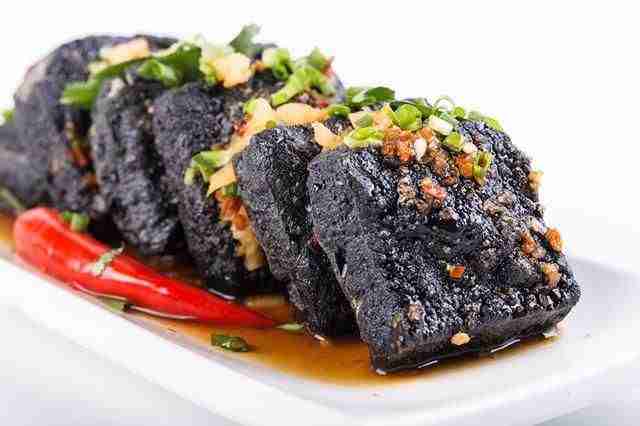
century egg vs fermented bean curd
Century egg and fermented bean curd are both traditional Chinese foods that are often used as condiments or ingredients in various dishes. While they may share some similarities, there are also some key differences between the two.
Century egg, also known as preserved egg or thousand-year egg, is made by preserving duck, chicken or quail eggs in a mixture of clay, ash, salt, quicklime, and rice straw for several weeks to several months. This process causes the egg white to become a translucent jelly-like substance with a gelatinous texture, while the yolk turns into a creamy, dark green or brown substance with a distinct flavor and aroma.
Fermented bean curd, on the other hand, is made by fermenting tofu in a brine made from rice wine, salt, and various seasonings such as chili, ginger, and garlic. The tofu becomes soft and creamy, with a slightly tangy, pungent, and salty flavor.
In terms of flavor, century egg and fermented bean curd are both considered to be strong and acquired tastes, and may not be enjoyed by everyone. However, they are used in different ways in cooking. Century egg is often used in congee, noodles, and as a side dish, while fermented bean curd is commonly used as a condiment for rice or stir-fried vegetables.
Nutritionally, century egg and fermented bean curd are both relatively high in protein and calcium, but century egg is also high in sodium due to the preservation process. Fermented bean curd, on the other hand, is lower in sodium but may contain higher levels of cholesterol and fat due to the tofu used in the fermentation process.
Overall, while century egg and fermented bean curd share some similarities as traditional Chinese foods with strong flavors, they also have some distinct differences in terms of their production process, flavor, and nutritional profile.
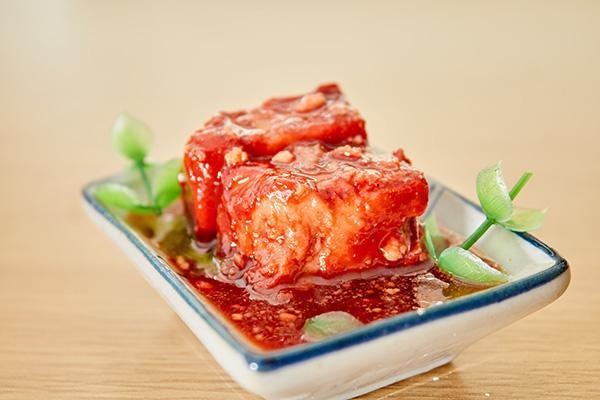
century egg vs balut
Century egg and balut are both unique food items with a distinct flavor profile and texture, but they are quite different from each other.
Century egg, also known as preserved egg or thousand-year egg, is a Chinese delicacy made by preserving duck, chicken, or quail eggs in a mixture of clay, ash, salt, quicklime, and rice straw for several weeks to several months. The egg white turns into a translucent, jelly-like substance with a slightly sweet and salty flavor, while the yolk becomes a creamy, pungent, and ammonia-like flavor.
On the other hand, balut is a fertilized duck egg that is boiled and eaten with the embryo inside. It is a popular street food in Southeast Asian countries like the Philippines, Vietnam, and Cambodia. Balut has a distinct texture and flavor that is both savory and slightly sweet, with a unique crunchiness from the partially formed bones and feathers of the duck embryo.
In terms of taste, century egg and balut are both acquired tastes and may not be for everyone. However, they are quite different in terms of texture, as the century egg has a smooth and jelly-like texture, while balut has a more solid texture due to the partially formed embryo inside. Additionally, balut has a more distinct and pronounced flavor, while the flavor of century egg is more subtle.
Overall, both century egg and balut are unique and culturally significant foods that are enjoyed in different parts of the world. However, due to their distinctive flavors and textures, they may not appeal to everyone’s taste buds.